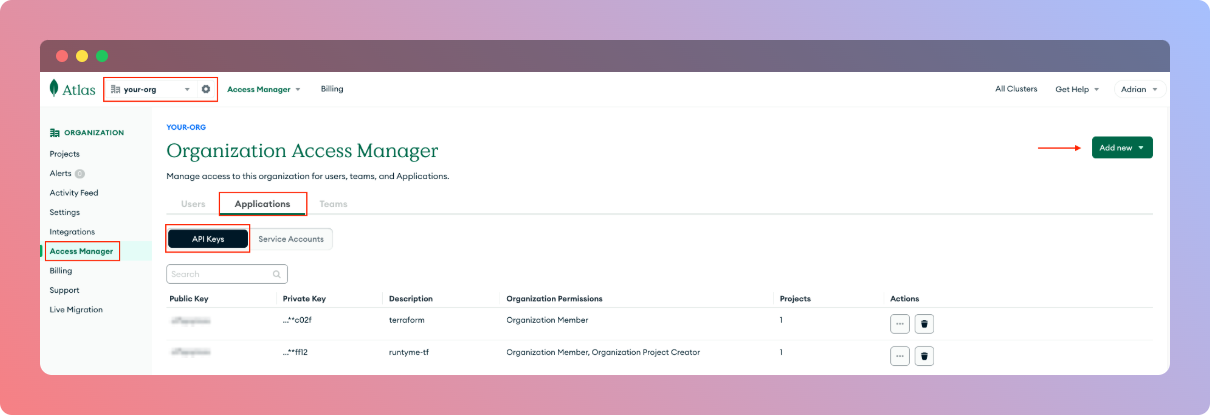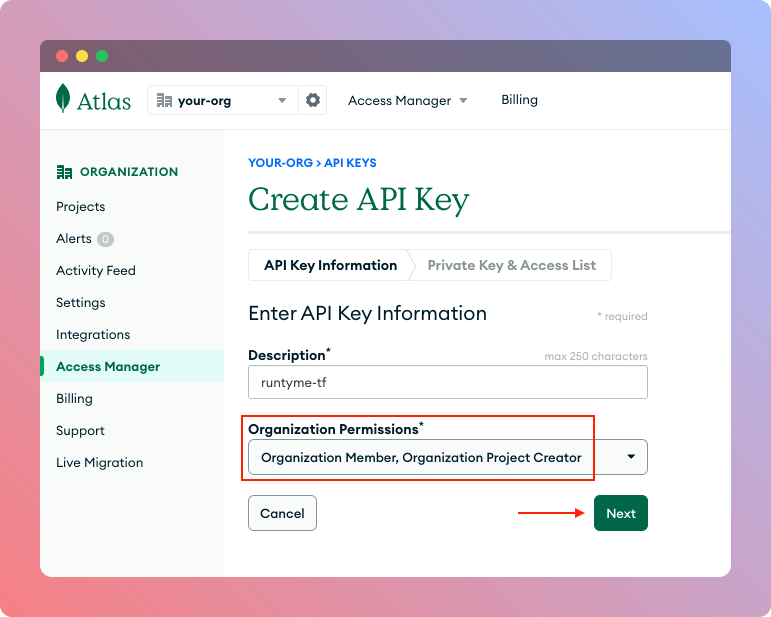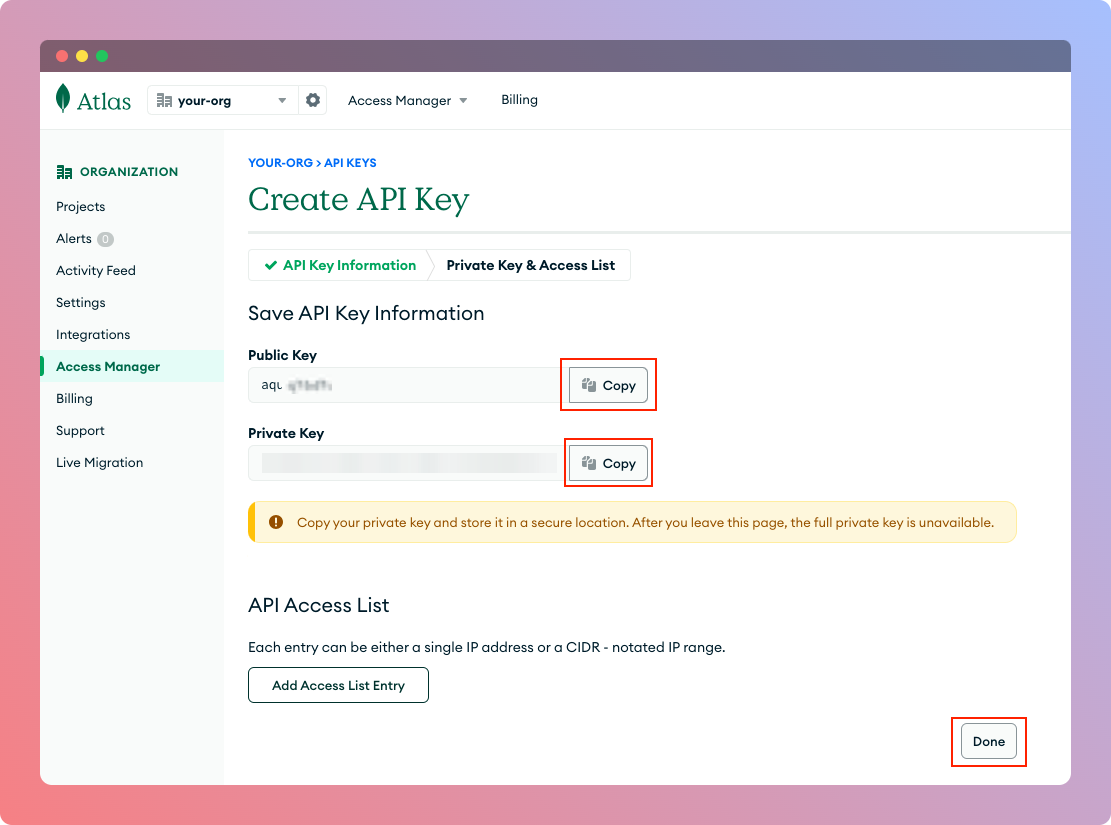MongoDB (NoSQL)
Prerequisites
To enable Mongo database, first you must have runtyme-kit pushed to the repostiory you've created in Get started step.
If you don't have it setted up yet, please go back to Get started step. Otherwise:
- Make sure your repository has
TF_ENABLEDenvironment variable set totrue, if not follow Installation step. - Make sure your Infrastructure Backend is configured (
TF_BACKEND_PG_CONN_STRexists), if not follow State Management step. - Signup to MongoDB Atlas here if you don't have an account yet.
Get Organization ID
- Go to your MongoDB Atlas dashboard
- Find your organization
- Click
Settingsicon in top navigation bar - You should see a page with panel called
Organization ID, copy the value from this panel

Get MongoDB public and private key
To get public and private key of your MongoDB Atlas organization you have to log into your dashboard, select your organization and click Settings button next to your organization's name on top nav bar. Then you'll be navigated to Organization Access Manager page, where you'll see Applications tab, click it, select API Keys and then tap Add new button on the right side of your screen.

After clicking Add new button, you'll see API Key creation wizard form, name your key however you want and select Organization Member and Organization Project Creator permissions. Then click Next

Finally, you'll see your Public Key and Private Key, make sure you copy and save them in a safe space. You'll use them in next step.

GitHub Actions
Your CI/CD runner will use MonogDB's Private and Public Keys as secured secrets environment variable to orchestrate MongoDB Atlas changes. It'll also use organization id to identify where to put your database configuration.
- Go to your repository's Settings tab, under
SecurityclickSecrets and variables->Actions - Click
New repository secret, name itTF_VAR_MONGODB_PUBLIC_KEYand paste the Public Key you've created as a value. - Click
New repository secret, name itTF_VAR_MONGODB_PRIVATE_KEYand paste the Private Key you've created as a value. - Click
New repository secret, name itTF_VAR_MONGODB_ORGANIZATION_IDand paste the organization identifier.
Configure __env.tf
You'll be configuring MongoDB Atlas just from one file, which is infra/__env.tf. In this file you'll find plenty of disabled yet already configured resources, but in this guide we'll be looking at mongodb under Persistence segment.
- To enable
mongodbresource, you need to switchenabledflag totrue, specifydb_nameanddb_user. - It is recommended to also specify
regionbut it is not required, default value would beEU_CENTRAL_1. Available values can be found here (runtyme-kit uses AWS as provider). - (non free tier) If you're not running on free tier, your can also specify
sizeof the instance. Free tier is alwaysM0. Available values can be found here. Keep in mind that non free tiers might require changes in source code of runtyme-kit, specificallyinfra/modules/mongodb/instancemodule.
locals {
...
mongodb = {
// might take couple of minutes when creating it
enabled = true
// (required) Name of the project and the database instance
db_name = "[YOUR_DB_NAME]"
// (required) Name of your API's connecting user, that will be authenticated to your MongoDB instance
db_user = "[YOUR_DB_USERNAME]"
// (optional) Instance size of MongoDB Atlas, either `M0`, `M2`, `M5` - available values can be found here: https://www.mongodb.com/docs/atlas/reference/amazon-aws/#cluster-configuration-options
// default: 'M0'
// NOTE: `M0` - Is a Free Tier cluster with 0.5 GB storage, learn about differences here: https://www.mongodb.com/docs/atlas/reference/free-shared-limitations/
// NOTE: for anything more than `M5` tier, custom solution (modifying source code) is necessary
size = "M0"
// (optional) AWS region on which the MongoDB Atlas database cluster will be deployed on. Available values can be found here: https://www.mongodb.com/docs/atlas/reference/amazon-aws/#amazon-web-services--aws-
// default: 'EU_CENTRAL_1'
region = "EU_CENTRAL_1"
}
...
}
When you make desired changes, push the code into the repository (create Pull Request or push it directly to default branch, it's up to you) and you should see Action Job being executed. Make sure to validate scheduled changes to your infrastructure, or potential errors.
Connection string and database name of MongoDB will be automatically attached to the running application (if heroku.enabled = true)